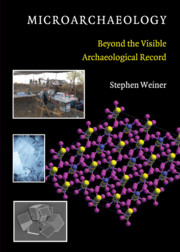Book contents
- Frontmatter
- Contents
- Preface
- 1 Archaeology, Archaeological Science, and Microarchaeology
- 2 Information Embedded in the Microscopic Record
- 3 Completeness of the Archaeological Record
- 4 Common Mineral Components of the Archaeological Record
- 5 Biological Materials: Bones and Teeth
- 6 Biological Materials: Phytoliths, Diatoms, Eggshells, Otoliths, and Mollusk Shells
- 7 Reconstructing Pyrotechnological Processes
- 8 Biological Molecules and Macromolecules: Protected Niches
- 9 Ethnoarchaeology of the Microscopic Record: Learning from the Present
- 10 Absolute Dating: Assessing the Quality of a Date
- 11 Reading the Microscopic Record On-Site
- 12 Infrared Spectroscopy in Archaeology
- Appendix A Identifying Minerals Using Microchemical Analysis
- Appendix B Identifying Minerals and Compounds Using Infrared Spectra: Table of Standard Minerals and Compounds for Which Infrared Spectra Are Available
- References
- Index
- Plates section
Appendix A - Identifying Minerals Using Microchemical Analysis
Published online by Cambridge University Press: 05 June 2012
- Frontmatter
- Contents
- Preface
- 1 Archaeology, Archaeological Science, and Microarchaeology
- 2 Information Embedded in the Microscopic Record
- 3 Completeness of the Archaeological Record
- 4 Common Mineral Components of the Archaeological Record
- 5 Biological Materials: Bones and Teeth
- 6 Biological Materials: Phytoliths, Diatoms, Eggshells, Otoliths, and Mollusk Shells
- 7 Reconstructing Pyrotechnological Processes
- 8 Biological Molecules and Macromolecules: Protected Niches
- 9 Ethnoarchaeology of the Microscopic Record: Learning from the Present
- 10 Absolute Dating: Assessing the Quality of a Date
- 11 Reading the Microscopic Record On-Site
- 12 Infrared Spectroscopy in Archaeology
- Appendix A Identifying Minerals Using Microchemical Analysis
- Appendix B Identifying Minerals and Compounds Using Infrared Spectra: Table of Standard Minerals and Compounds for Which Infrared Spectra Are Available
- References
- Index
- Plates section
Summary
The elemental compositions of minerals in embedded and polished blocks of sediments can be determined using the electron microprobe, or with energy and/or wavelength dispersive detectors (EDS and/or WDS) in a scanning electron microscope. The results are usually presented as an indication, but not a confirmation, of the mineral phase present. A detailed analysis can, however, be used to identify the mineral phase with a reasonable degree of certainty. The approach is to use the elemental analysis to calculate the chemical formula of the suspected mineral. The ideal number of oxygen atoms of the suspected mineral is used, and not the amount of oxygen analyzed. If the calculated formula is similar to the actual chemical formula, it is reasonable to assume that this is indeed the correct mineral phase.
Table A.1 is an example of the output of a typical elemental analysis of a mineral. Following are the steps used to identify the mineral phase:
A first check of the quality of the analysis is whether the sum of the amounts of compounds is close to 100% (column 4 in Table A.1). In the example in Table A.1, the water and volatite contents were not analyzed, so the sum cannot be 100%, but should be close to 100%.
A guess of the possible mineral phase is then made, based on the major elements present. In the example in Table A.1, a good guess would be the mineral carbonate hydroxylapatite. As carbon was not analyzed, the question is whether the analysis obtained corresponds to hydroxylapatite. In the software program used for elemental analysis, open the method called “stoichiometry normalized results (oxygen by stoichiometry).” Then calculate the number of oxygens from the general chemical formula of the mineral hydroxylapatite: Ca5(PO4)3(OH,F,Cl). Note that the number of oxygens is the number in the formula (i.e., 13 oxygens: 12 in the phosphate position and 1 in the hydroxyl position). A correction needs to be made for the cations that were not analyzed, in this case, the hydrogen of the hydroxyl group. A half oxygen needs to be subtracted as two hydrogens are needed for each oxygen to make a compound. As this results in 12.5 oxygens, it is better to duplicate the formula [Ca10(PO4)6(OH,F,C)2] and use 25 oxygens (anions). Another useful example of this calculation is calcite. The calcite formula, CaCO3, has three oxygens, but two of them are associated with the carbon, which is usually not analyzed. Therefore the number of oxygens used for the calculation is one.
[…]
- Type
- Chapter
- Information
- MicroarchaeologyBeyond the Visible Archaeological Record, pp. 317 - 319Publisher: Cambridge University PressPrint publication year: 2010



